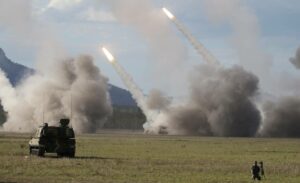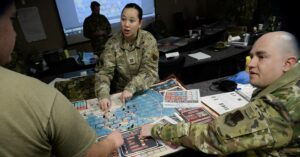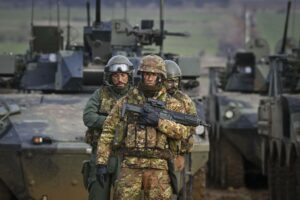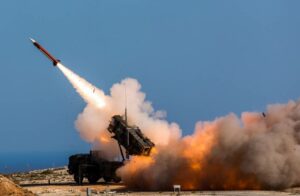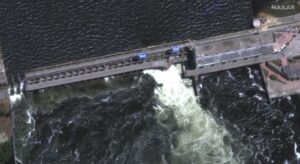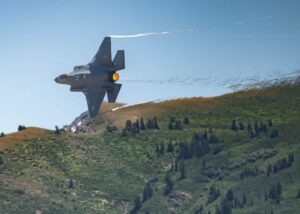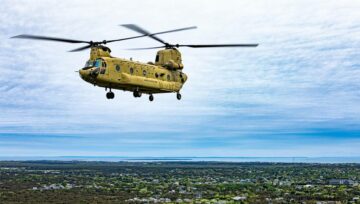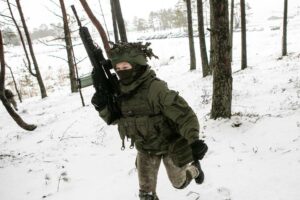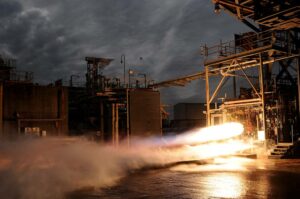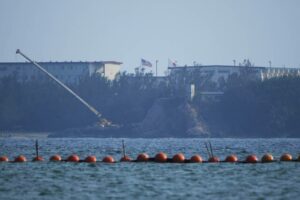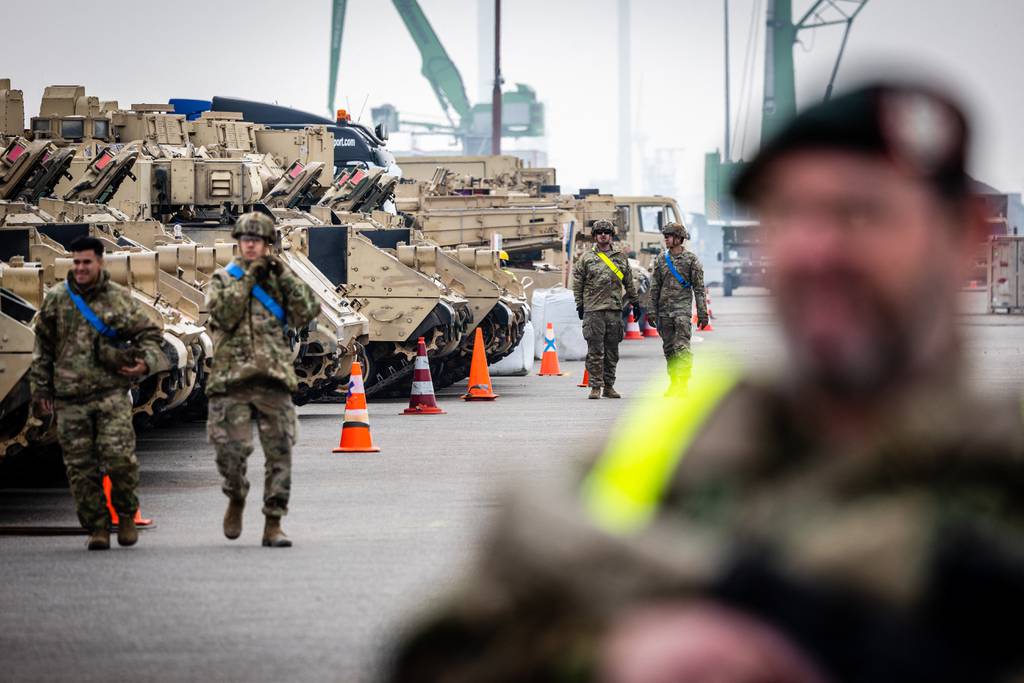
PARIS — Germany, the Netherlands and Poland plan to develop a military corridor that would make it easier to move troops and equipment between Europe’s North Sea ports and NATO’s eastern flank, at a time of growing hostility with Russia.
The countries signed a declaration of intent on Jan. 30 to develop the corridor, with plans to tackle infrastructure choke points, such as low bridges, and slash bureaucracy around permits for cross-border transport of ammunitions and other dangerous goods, the Dutch Ministry of Defence said in a statement. They’ll also study how military rail transports can be prioritized over routine civilian traffic.
Russia’s invasion of Ukraine two years ago made European countries realize they need to be prepared to move their military across the continent, something that previously hadn’t been high on the agenda, Dutch Defense Minister Kajsa Ollongren said at the Military Mobility Symposium in Brussels on Jan. 30. She said the Netherlands, as a military transit country, must able to quickly move equipment from its ports to the hinterland.
“It’s about heavy material that has to pass through on bridges and roads, but it’s also about bureaucracy, it’s also about red tape,” Ollongren said. “We know one thing for sure: If the crisis comes, we are not going to have the time to do our paperwork, the paperwork has to be ready.”
The three governments will study how to standardize the conditions around military transports, including priority for military trains, fewer rules for military convoys and border crossings, as well as resting and refueling stops. The Netherlands coordinates the military mobility project of the EU Permanent Structured Cooperation, or PESCO.
Germany relied on military mobility as a frontline nation during the Cold War, and as the borders have moved east, Berlin needs to offer the same to allies, German State Secretary of Defense Siemtje Möller said in Brussels. Europe needs to demonstrate to Russia its ability to process military personnel and goods via its ports, roads and rail, she said.
European countries are playing catchup after decades of underinvestment following the end of the Cold War, said Sarah Tarry, head of the NATO Defence Policy and Capabilities Directorate. She said the agreement between Germany, Poland and the Netherlands “is absolutely a great model, and we need to do more like this to address the challenges.”
Europe’s three largest ports are Rotterdam in the Netherlands, Antwerp in Belgium and Hamburg in Germany, connected to inland destinations by waterways and an extensive network of roads and railway tracks.
“We have forces that are forward stationed in Europe, but then the vast majority of our forces are still in the United States,” Secretary of Defense Representative in Europe Rachel Ellehuus said at the mobility forum. “So we’d be relying on that throughput across the Atlantic and that ability to be quickly received in Europe.”
Europe has supported Ukraine with military aid in its defense against Russia, and defense budgets have increased across the EU in response to the Russian aggression. Former Russian President Dmitry Medvedev, now deputy Chair of the Security Council of the Russian Federation, in November labeled Poland a “dangerous enemy.”
NATO last week announced plans to conduct Steadfast Defender, the largest exercise in Europe since the Cold War, with about 90,000 troops from all NATO allies as well as Sweden taking part. The exercise aims to test NATO defense plans against a near-pear adversary, and will result in troops transiting Dutch ports and German roads and railways.
Ollongren said governments should use the NATO exercise to explain how investment in infrastructure will increase resilience and improve deterrence. “It’s also going to show to our adversaries, especially the Russian Federation, that we are ready for this,” the minister said.
The EU earlier this month said it would fund 38 additional projects to facilitate transport of troops and equipment for €807 million ($875 million), raising its support for military mobility for the 2021-2027 period to a total of 95 projects and €1.7 billion.
“The quicker we can move military forces from one part of Europe to another, via land, sea or air, the better our readiness to handle sudden challenges,” said Jiří Šedivý, chief executive of the European Defence Agency. “Russia’s aggression against Ukraine has increased the urgency of this indeed.”
Rudy Ruitenberg is a Europe correspondent for Defense News. He started his career at Bloomberg News and has experience reporting on technology, commodity markets and politics.
- SEO Powered Content & PR Distribution. Get Amplified Today.
- PlatoData.Network Vertical Generative Ai. Empower Yourself. Access Here.
- PlatoAiStream. Web3 Intelligence. Knowledge Amplified. Access Here.
- PlatoESG. Carbon, CleanTech, Energy, Environment, Solar, Waste Management. Access Here.
- PlatoHealth. Biotech and Clinical Trials Intelligence. Access Here.
- Source: https://www.defensenews.com/global/europe/2024/01/31/europeans-set-up-corridor-for-rushing-nato-troops-eastward/
- :has
- :is
- :not
- $UP
- 000
- 30
- 7
- 70
- 8
- 90
- a
- ability
- Able
- About
- absolutely
- across
- Additional
- address
- After
- against
- agency
- agenda
- ago
- Agreement
- Aid
- aims
- AIR
- All
- also
- an
- and
- announced
- Another
- ARE
- around
- AS
- At
- BE
- been
- Belgium
- berlin
- Better
- between
- Billion
- Bloomberg
- border
- borders
- bridges
- Brussels
- Budgets
- bureaucracy
- but
- by
- CAN
- capabilities
- Career
- Chair
- challenges
- chief
- Chief Executive
- cold
- comes
- commodity
- conditions
- connected
- continent
- cooperation
- corridor
- Council
- countries
- country
- crisis
- cross-border
- Dangerous
- decades
- defence
- Defense
- demonstrate
- deputy
- destinations
- develop
- do
- during
- Dutch
- Earlier
- easier
- East
- eastern
- EC
- end
- equipment
- especially
- EU
- Europa
- Europe
- European
- European Countries
- Europeans
- Europes
- executive
- Exercise
- experience
- Explain
- extensive
- facilitate
- Federation
- fewer
- following
- For
- Forces
- Former
- Forum
- Forward
- from
- German
- Germany
- going
- goods
- Governments
- great
- Growing
- hamburg
- handle
- Have
- he
- head
- heavy
- High
- his
- How
- How To
- HTTPS
- if
- images
- improve
- in
- Including
- Increase
- increased
- indeed
- Infrastructure
- inland
- intent
- invasion
- investment
- IT
- ITS
- Jan
- jpg
- Know
- Land
- largest
- Last
- like
- Low
- made
- Majority
- make
- Markets
- material
- Military
- million
- minister
- ministry
- mobility
- model
- Month
- more
- move
- moved
- must
- nation
- Need
- needs
- Netherlands
- network
- news
- North
- North Sea
- November
- now
- of
- offer
- on
- ONE
- or
- Other
- our
- Outlook
- over
- paperwork
- part
- pass
- period
- permanent
- permits
- Personnel
- plan
- plans
- plato
- Plato Data Intelligence
- PlatoData
- playing
- points
- Poland
- policy
- politics
- ports
- prepared
- president
- previously
- prioritized
- priority
- process
- projects
- protection
- quicker
- quickly
- Rail
- Railway
- railways
- raising
- Readiness
- ready
- realize
- received
- Red
- Refueling
- relying
- Reporting
- representative
- resilience
- response
- resting
- result
- roads
- routine
- rules
- Russia
- russian
- russian federation
- Russian president
- Said
- same
- SEA
- secretary
- security
- set
- she
- should
- show
- signed
- since
- something
- started
- State
- Statement
- States
- Still
- Stops
- structured
- Study
- such
- sudden
- support
- Supported
- sure
- Sweden
- tackle
- taking
- tape
- Technology
- test
- that
- The
- the Netherlands
- their
- then
- they
- thing
- this
- three
- Through
- throughput
- time
- to
- Total
- tracks
- traffic
- trains
- transit
- transport
- two
- Ukraine
- United
- United States
- urgency
- use
- Vast
- via
- war
- we
- week
- WELL
- will
- with
- would
- years
- zephyrnet

